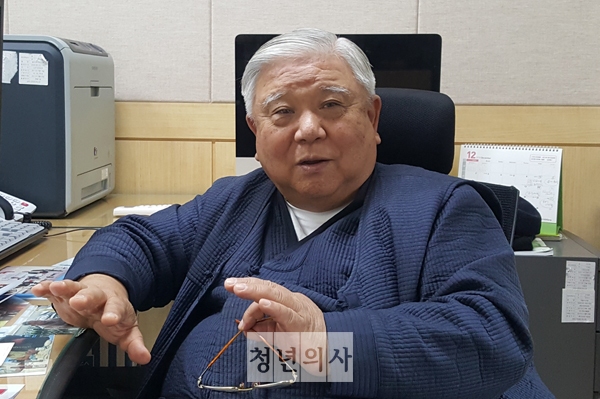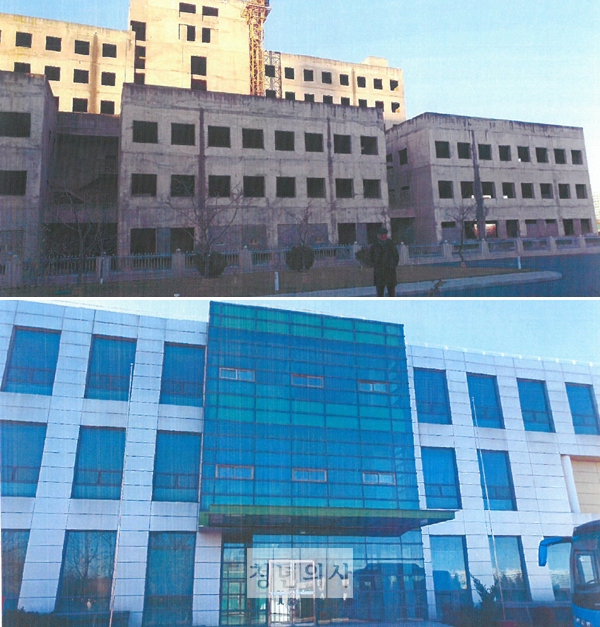[Interview]‘N. Korea wants to resume healthcare exchanges,’ says co-leader of Korean Sharing Movement
There is a doctor who has visited North Korea several dozen times since 1989. He also was behind the establishment of public health infrastructure in the North, including the construction of the Third Pyongyang Hospital in 1995 and the Care Fluid Factory in 2005. Lee Il-yung, co-president of the Korean Sharing Movement, is the doctor.
After graduating Yonsei University College of Medicine in 1969, Lee acquired licenses as the specialist of the rehabilitation medical treatment, and has since served as the professor of Rehabilitation Medical Treatment Department in Ajou University College of Medicine, president of Korean Association of Rehabilitation Medicine, president of Korean Society of Spinal Cord Injury, and the first director of Prume Foundation Nexon Children’s Rehabilitation Hospital.

Lee could visit North Korea frequently since the 1980s because he was a U.S. citizen. Lee, who went to the U.S. in 1973, received training as the specialist of rehabilitation medical treatment at the New York University Hospital, worked as a doctor in America for 10 years, and acquired the U.S. citizenship.
Lee, who hailed from Haeju, Hwanghae Province, in North Korea, naturally developed interests in unification movement and visited the North for the first time in 1989 on the occasion of the World Festival of Youth and Students in Pyongyang. Since he returned from the U.S. in 1994, Lee has steadily served in the NGOs related to North Korea, including the Korean Sharing Movement. He is also a co-representative of Rail Hope, which strives to connect railways along the northern coast of the East Sea between the two Koreas.
Lee has paid close attention to North Korea’s healthcare area by making the most of specialty and his status to visit the North relatively frequently as a U.S. citizen. He contributed to improving poor healthcare environment in the North by helping to establish the Third Hospital in Pyongyang and the Care Fluid Factory.
Lee visited North Korea three times in October and November since the frozen ties between the two Koreas began to melt since the first summit between President Moon Jae-in and North Korean leader Kim Jong-un in Panmunjeom on April 27. It was his first visit to the North in about six years since the Lee Myung-bak imposed economic sanctions on the isolated regime on May 24, 2012. Korea Biomedical Review met Lee who returned from this four-day visit to Pyongyang from Nov. 21-24, at Welfare Center for Handicapped in Gwacheon, south of Seoul. Lee said North Korea had changed much after many years.
The most significant change of all was North Korean people have brightened up. He expressed regrets, however, for the remnants of long-severed ties between the Koreas caused by the May 24, 2012 sanctions. Lee said he hoped the two Koreas would be able to resume suspended projects in healthcare area through reinvigorating exchanges and cooperation between them.

Question: How did you find North Korea visiting it after a long hiatus?
Answer: I visited the North for the first time this year since I was there in 2012 as part of the Korean Sharing Movement’s projects. This time around, I found changes in North Korean people’s faces. They seemed at ease while talking about peace and prosperity.
Q: We heard you visited the inter-Korean exchange projects that had been suspended because of May 24, 2012 sanctions.
A: Before the May 24, 2012 sanctions, the two Koreas briskly conducted exchanges in the healthcare area, but all interchanges had been suspended since then. Cho Yonggi Children’s Cardiology Hospital had not even finished the construction of the building.
North Korean officials said they hoped the hospital would complete its construction as early as possible and serve as the specialized center that can carry out all heart surgeries.
Nor did Rakrang Pyongyang People's General Hospital, which was built by Korea Food for the Hungary International (KFHI) from 2006-2008, could start operation with its doors locked. KFHI could finish the construction of the building but could not put the equipment and materials in it because of the May 24, 2012 sanctions.
The Third Hospital in Pyongyang also requires an upgrading. It has 500 sickbeds, but the facilities are inadequate. It urgently needs to replace old equipment that had been used for long.
Q: Aside from hardware parts, such as equipment and facilities, how about software part?
A: North Korean medical workers’ quality is quite high. I found North Korean physicians’ levels were high when I attended Pyongyang Medical and Scientific Forum that has been held every May since 1999. Given the right conditions, I think they will be able to develop far more than now. The April 27 inter-Korean agreement at Panmunjeom and other events will provide opportunities to revitalize inter-Korean exchanges of medical workers. As hardware support for the North is difficult because of the U.N. sanctions on the reclusive state, I think we need to speed up personnel exchanges.
Q: How were other hospitals than those mentioned already?
A: Newly built hospitals had reached a considerable level. Okryu Children’s Hospital, Ryukyung Ophthalmological General Hospital and Ryukyung General Hospital seemed to have decent facilities in the Munsu District along the Daedong River. The eye hospital in particular boasted good facilities and one person in our visiting group got a new pair of glasses there.
Pyongyang has developed much. The problem is the rest of North Korea. Road conditions are too weak in the North. All railroads there are single-track rails, and cross-ties need to be replaced, but the country is short of new ties. Roads and railways should first be rebuilt so that visits to the North can get more comfortable, and inter-Korean exchanges are reinvigorated.
Q: Is that also why you serve as the co-representative of Rail Hope, which strives to reconnect railways along the northern coast of the East Sea between the two Koreas?
A: That’s right. I think the reconnection of inter-Korean railways is like a job that connects blood vessels of the Korean Peninsula. As blood can circulate by connecting vessels, Koreans can visit the other half of the peninsula only when their railroads are reconnected.
Particularly the East Sea Railroad is the rail that starts from Busan and continues through Wonsan. If this railway is inter-joined, we will not just be able to go to Europe by riding the Cross-Siberian train in Vladivostok but also will travel to Europe from Busan. However, the rails are severed in the 110-km section from Gangneung to Jejin, or Goseong. The severed section is the Donghae Bukbu (Northern Part of East Sea) Line.
Q: What is the “Tie Donation Movement” conducted by Rail Hope?
A: We need cross-ties to reconnect rails. In North Korea in particular, they should replace all ties. This is why Rail Hope is staging the cross-tie donation campaign to reconnect Donghae Bukbu Line. The only way the Korean Peninsula can overcome disabilities and inter-join its vessels and nerves is peaceful coexistence of South and North Korea. And the most necessary thing for the peaceful coexistence is to open ways for frequent visits to each other.
The comfortable travel will also make exchanges and cooperation in the healthcare sector far brisker. I hope the medical community will show more interest in reconnecting Donghae Bukbu Line.

